The stopping of the German armored raids deep in the territory of the USSR in 1941 and 1942 was the most important thing for the Red Army. The Soviets did not keep up with the minefields, because the Germans were usually faster. In Moscow, therefore, it was decided to use "movable" mines. The ... anti-tank dogs carrying explosives on their backs went to the front. Soviet Sobaks were to destroy tanks and die with them.
"Everything is possible in a war," said Marusia Ogoniok to the astonished Lidka, when they heard the clatter of the tracks of a German tank far behind the front, in the area long occupied by the Red Army. And - although this statement was made in a popular book - she was right. German tankers found this out when they encountered perhaps the strangest weapon of World War II - dog mines on the Eastern Front. There is no doubt that it was a weapon that posed a threat to both attacked and attackers.
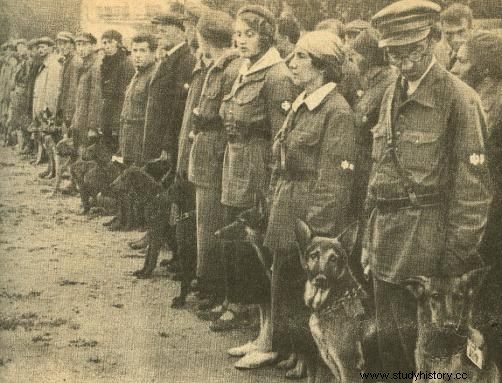
Anti-tank dog training center in the Moscow region (1931)
The use of dogs for combat purposes has almost as long a history as the use of horses or elephants in warfare. Also in tsarist Russia, dogs were used for sentinel tasks or searching for fugitives. Of course, such dogs were not forgotten in the USSR - a country focused on surveillance and supervision of citizens. As early as 1924, the Central School of Military Dogs was established in which they were prepared for service in the army. Initially, the tasks the dogs were trained for were rather common:carrying reports, ammunition, food rations, pigeon cages, developing telephone cables, searching for mines and keeping watch.
Sanitary dogs and dogs-mines
More specialized "medical dogs" were also trained, whose task was to support the paramedics operating on the battlefield - these were to carry bags with dressings on the backs, as well as transport the wounded to the rear. For this purpose, carts pulled by several dogs were used. The dogs and strollers with the injured were low, so more difficult to hit than, for example, two paramedics in an upright position carrying the wounded on a stretcher. Thus, a wounded soldier placed on a wheelchair by a paramedic had a better chance of reaching the dressing point without further injuries, and the paramedic could stay on the spot and help the next wounded. The Russians used sanitary sledges during the fighting for Berlin in April and May 1945. Russian historians say that this method of medical transport saved about 700,000 soldiers!
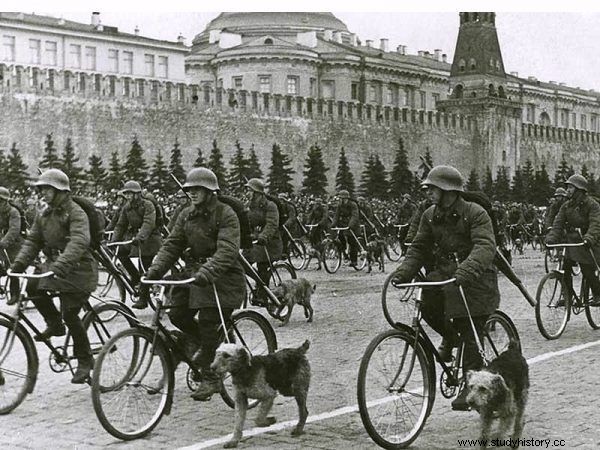
A parade of Red Army soldiers with anti-tank dogs on Red Square in Moscow (1938)
Probably during the training of dogs carrying medical packages on their backs, the idea of using them in an "offensive" way emerged. The task of investigating the potential of such a solution was entrusted to the Military Dogs School in the Ulyanovsk-on-Volga Military District. A training program has been developed, including taming animals with bangs, smoke and explosions. During the first stage of training, the dogs were not given food for several days, and then they were released into the exercise yard and given the command to search.
Food for animals was hidden under tracked tractors or tanks. Initially, the vehicles were standing, then they also trained to look for food under moving tanks. The dogs were also getting used to the smell and loud sounds made by the tank . This loud and smelly vehicle was supposed to be associated with something good, so that they would run up to it without fear. Initially, attempts were made to teach dogs to leave explosive bags in front of tanks, but it turned out that this task was too difficult even for the most intelligent individuals. So a simpler solution was found.
The plan for the combat use of "anti-tank dogs" was simple. They had to be starved for a few days before the expected attack, and then released onto the battlefield under the advancing enemy tanks. A dozen or several dozen dogs released in the attack line of German tanks created a "moving minefield", which - in theory - should stop the enemy. The dogs-mines were carrying two bags with loads of 6 kg of TNT on their backs. Between the bags was a detonator protruding like an antenna, armed before the dog was unleashed. It was expected that the dog would run up to the enemy tank looking for food and run into the tracks. At this point, the "antenna" placed on the dog's back, which caused the explosion, was about to break. It was not assumed that any of the dogs would survive the mission. The dog-mine was unfortunately treated as a single-use weapon ...
Dogs on the battlefield
The opportunity to test the assumptions from the period of dog training in practice came in 1941, when German armored units penetrated deep into the territory of the USSR. In desperate defense, all holds were allowed. The dogs went into action in the late summer and fall of 1941. The first attack involved 20 dogs, but no success was reported. Some dogs escaped, others died under the tracks of tanks or from artillery fire. It did not go well in the following actions either. Dogs - already with armed loads - tried to hide in Soviet trenches, return to their owners, and even fawn at them.
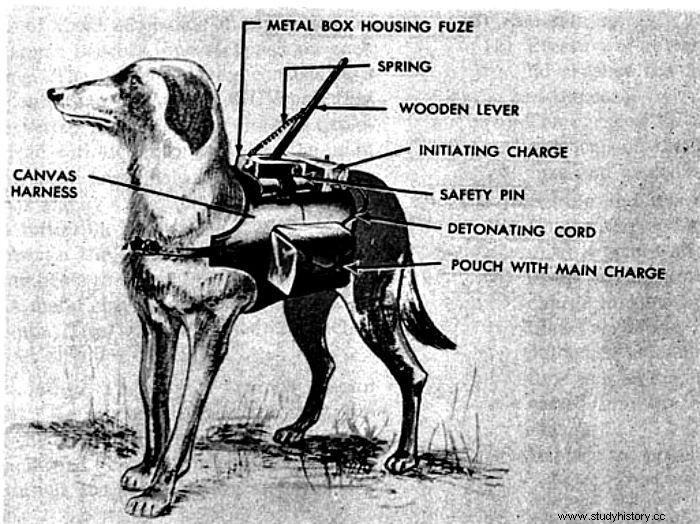
The attack of the Soviet dog-mines was described in his memoirs by Lt. Col. Hans von Luck, commander of the 7th Panzer Division. The Germans noticed at once that, in the absence of fire, a charge exploded under the tank and the dog was around. The case was investigated, the dog's carcass was examined, and conclusions were drawn. All dogs running in the area were ordered to fire immediately, and information about the new threat was transmitted by radio to other armored units. "Unfortunately for them, we had to shoot all the dogs we saw approaching us," recalled von Luck.
Psy-mines were a threat not only to foreign tanks, but also to their own. The animals recognized Soviet tanks as theirs because of the familiar smell of fuel, gunpowder and lubricants. German tanks were foreign to them, they smelled completely different, so the dogs preferred to avoid them. The information that anti-tank dogs would attack on a given section of the front caused panic also among Soviet tankers who - to reduce the threat - used a simple protection - they mounted steel aprons on the tanks to prevent dogs from running between the tracks.
The dog-faces weren't as totally ineffective as they seem. Soviet combat reports mention numerous successful attacks by anti-tank dogs on German tanks. Under favorable conditions (fog, snowstorm) all released dogs reached their destination. In winter, white camouflage throws were worn to prevent them from being visible in the snow. Successful attacks were recorded in the battles near Moscow in 1941, at Stalingrad and Rostov in 1942 and in 1943 near Voronezh. In 1942, almost 1,000 dog handlers and 800 trained anti-tank dogs were sent to the front. A small number of anti-tank dogs were also used during the Battle of the Kursk, where they were to be one of the many "minefields" prepared for the German attack that Soviet intelligence had known for a long time.
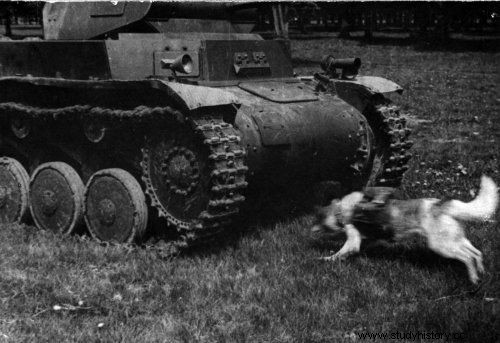
Photo from training
After the Battle of Kursk, the Red Army gained a decisive advantage over the Wehrmacht and attacked rather than defended itself. The production of tanks behind the Urals was in full swing, and the crews - if they had survived the previous fights - were already experienced. Thus, the armored Soviet-German clashes were more and more balanced, so the demand for unusual weapons, including psy-mines, was decreasing. It was decided that they should be withdrawn from the front, retrained and directed to other tasks - mainly mine detection, wounded transport and patrols behind enemy lines.
By the end of the war, 68,000 fighting dogs of all specializations were enlisted in the service of the Red Army. It is estimated that the mines destroyed some 300 German tanks, although this figure seems somewhat exaggerated. Unfortunately, Russian sources do not state how many dogs were killed and how many own tanks fell victim to this unconventional weapon.
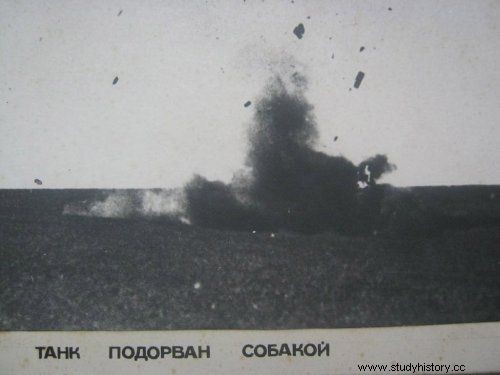
The history of mineshops is still alive today in Russia, although it is treated as a war legend. Psy-mines, however, found their way to monuments and museums. In the Central Museum of Artillery and Sapper Forces in Saint Petersburg, stuffed dog mines with various types of explosives are exhibited. In Moscow (in Victory Park, near the Church of Christ the Savior) and in Volgograd (Chekist Square) there are monuments to fighting dogs. The monument in Volgograd shows an anti-tank dog, and the one in Moscow shows a sanitary dog. A few years ago, the Russian modeling company Zvezda launched a set of figures of Red Army soldiers with anti-tank dogs. Dog-mines also appear in many articles about the strangest weapons of World War II and the use of animals on the battlefield.
On the pedestal of the dog monument in Moscow, it is written:"During the Great Patriotic War, the fighting dogs blew up over 300 fascist tanks, delivered 120,000 reports and combat reports, transported about 700,000. wounded from the battlefield. ”
